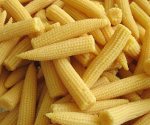 Young cob corn (Zea mays L.), the newly developed corn, has been used by Chinese as vegetable for generations and this practice has spread to other Asian countries. It is used as ingredient in most food preparations. It has nutritive value similar to that of non-legume vegetable such as cauliflower, tomato, cucumber and cabbage (Yodpetch and Bautista, 1983). This vegetable has a great potential for cooking purposes and for processing as a canned product. Canned cob corn export to Thailand, Japan and Europe is increasing and has a good future.
Young cob corn (Zea mays L.), the newly developed corn, has been used by Chinese as vegetable for generations and this practice has spread to other Asian countries. It is used as ingredient in most food preparations. It has nutritive value similar to that of non-legume vegetable such as cauliflower, tomato, cucumber and cabbage (Yodpetch and Bautista, 1983). This vegetable has a great potential for cooking purposes and for processing as a canned product. Canned cob corn export to Thailand, Japan and Europe is increasing and has a good future.
Generally, corn farmers strive their competitive position by improving yields and cutting cost of production, for instance, though shortening cultural risk by harvesting for either green corn or baby corn. Young cob corn has a short growth duration thus a farmer can grow four or more crops a year. It has a wide range of adaptation and does not need intensive cultivation. Pollination is also not a problem because young cob corn is harvested before kernels are developed. Considering these factors, young cob corn has good potentials.
Varieties
Sweet corn varieties are commonly used for the production of baby corn. In some areas of the country, Pioneer 305 and SMC (hybrid) varieties are being commercially grown for young corn. Golden Cross Bantam and Super sweet were also found to posses the best attribute of young cob corn. (Yodpetch and Bautista, 1983). IPB Var 1, IPB Var 2, IES Cn 1, IES Var 2 and Super sweet corn #33 were also proven to be suitable for young corn production (Masana et al., 1990).
Soil and Climate Requirements
The best soil for corn is a well-drained with a texture of silt loam or loam type. It should be a type of soil with a high moisture holding capacity, high amount of organic matter and be slightly acidic (pH 5.3 to 7.3). A rainfall of 200 to 1,500 mm is required in its growing period. However, the optimum requirement of corn is 400 to 600 mm per growing period. In time of moisture deficiency, irrigation is essential.
Land Preparations
* A seedbed which is deep, well pulverized yet fairly compact is excellent for corn.
* A clayey and weedy field requires more plowing. In a weedy field where trash is plowed under, a second or third operation may be needed to obtain a clean seedbed.
* Plowing is done when the field is at the right moisture, when the soil particles 13 cm. Below the ground separate, only a thin portion sticks to the finger but no ball is formed.
* For animal-drawn plow, a depth of 4 to 6 cm is sufficient. When tractor is used, 12 to 14 cm is preferable.
* Harrowing is done at the time the soil has the right moisture content. It is done again within two days before planting to level the soil.
Planting Method
1. Surface or Flat-bed Planting
Seeds are drilled or hill-planted on a level to slightly rolling topography at a desired depth and row spacing. It is suited for areas with abundant precipitation and heavy soil types.
2. Listed planting
Seeds are placed at the bottom o the V-shaped furrow. A lister which is double mold board blade is used for opening furrow of this kind. It is practiced in areas where rainfall is a limiting factor, where soil is drainage is good and the soil is friable.
3. Ridged Planting
The seeds are placed to a specified depth on top of the ridge. The conditions described in listed planting are also appropriate for this type.
If the soil contains considerable moisture at planting time, the seeds should be planted from 2 to 5 cm deep. On dry soil, the seeds should be planted 5 to 8 cm deep.
Rate of Seeding
The amount of seeds needed in a hectare to have a population density of 80,000 to 100,00 plants/hectare is 27 to 30 kg of hybrid seeds. The rows are spaced 100 cm with a hill spacing of 25 cm with 3 plants/hill or drilled 25 cm between hills. No thinning on corn seedlings will be done.
Irrigation
The field should be irrigated moderately even at the time of seed germination and during the early growth and development of corn plants. Weekly irrigation must be done especially during summer.
Fertilization
The recommended rate of fertilizer per hectare is 3 bags 14-14-14 and 1 bag Urea. One half of N and all of P and K is applied in the furrow and then cover 2 to 3 cm layer of soil before planting. The remaining half also of N is side dressed 20 to 30 days after planting. Fertilization may also vary as recommended by the Bureau of Soils as a result of a soil analysis.
Weeding
Weeds are the unwanted plant companion of crops. Besides serving as host to plant pest and diseases, weeds can reduce corn yield by as much as 50 to 80% if left uncontrolled.
Weeds are commonly controlled by hand weeding, hoeing within the rows and cultivation in between the rows.
Detasseling
Detasseling is achieved by removing all the tassels of corn plants. This is done as soon as the tassels emerge.
Crop Protection
Baby corn requires practically no application of pesticides because the crop has short growth duration thereby eliminating the residue factor and minimizing in production cost.
Harvesting
Timeliness is the most important consideration in harvesting baby corn. Ideally, young corn is harvested 2 to 3 days after silking or 50 to 55 days after emergence. Harvesting duration may last for 15 to 18 days which is carried on by hand picking.
Cobs for market must have a good quality. Young cob corn of excellent quality is straight, has uniform ovary alignment, is 4 to 11 cm. Long, 0.8 to 1.8 cm. In diameter, slightly yellow to yellow color, sweet and not fibrous (Yodpetch and Bautista). Cobs must be free from bites of corn borer, must be clean and not broken.
Prepared by: Lolita F. Masana (Agriculturist II, Crop Research Division, Bureau of Plant Industry)
Source: da.gov.ph
Do you like this Money making business ideas? then please consider subscribing to our PINOY BISNIS ![]() RSS feed. You can also subscribe by email and have new business ideas sent directly to your inbox. (Once you entered your e-mail address, you need to login to your e-mail account and click the link to confirm your subscription).
RSS feed. You can also subscribe by email and have new business ideas sent directly to your inbox. (Once you entered your e-mail address, you need to login to your e-mail account and click the link to confirm your subscription).




Hai i came from indonesia. I think Your article is very usefull for indonesia farmer. I waiting for another agroindustrie article
.-= Hilman Firmansyah´s last blog ..GAMBARAN UMUM KOMODITAS TANAMAN HIAS (Karakteristik Kegunaan Tanaman Hias dan Bunga) =-.
Very business minded person ung author nito. galing hehhee, exchange links po pwd??